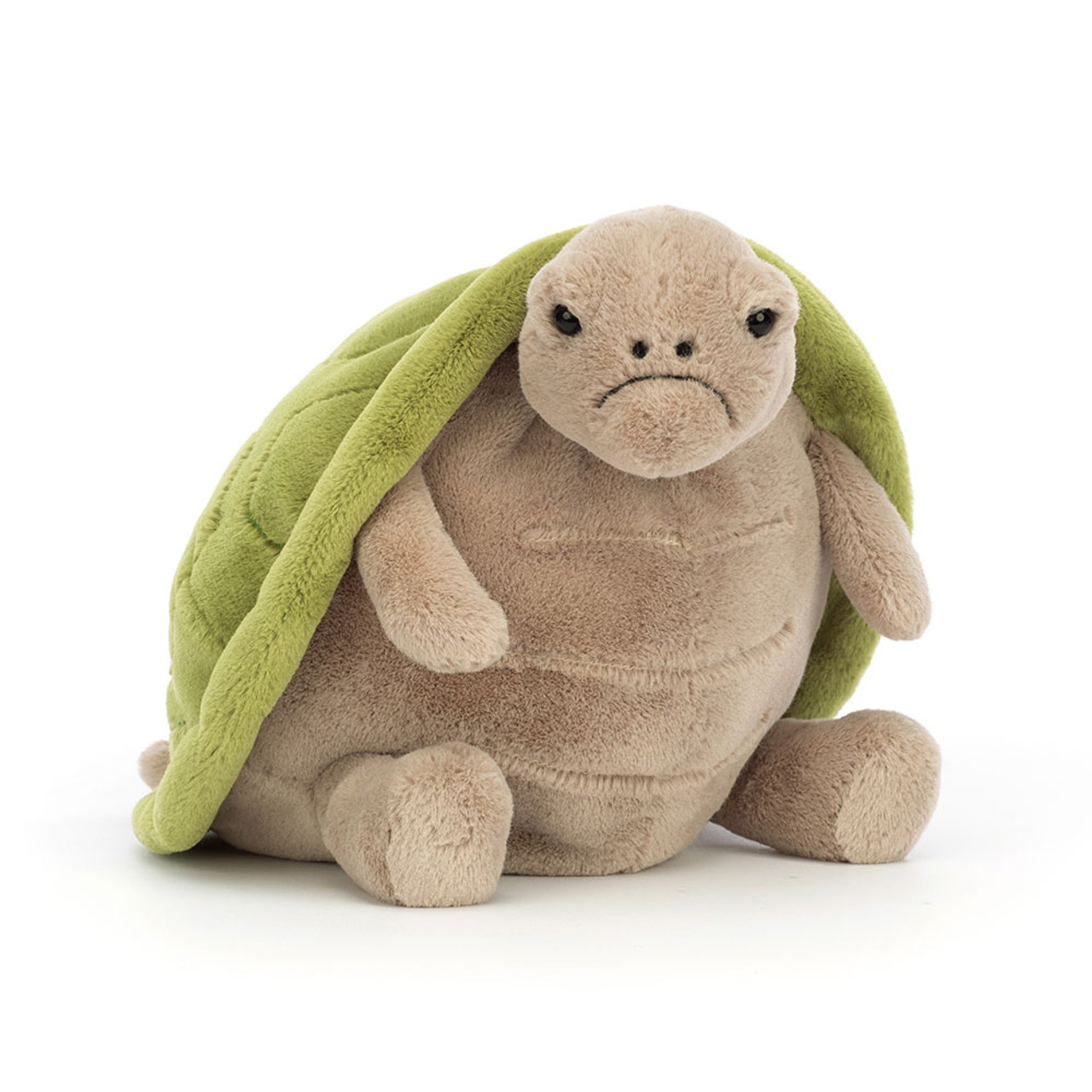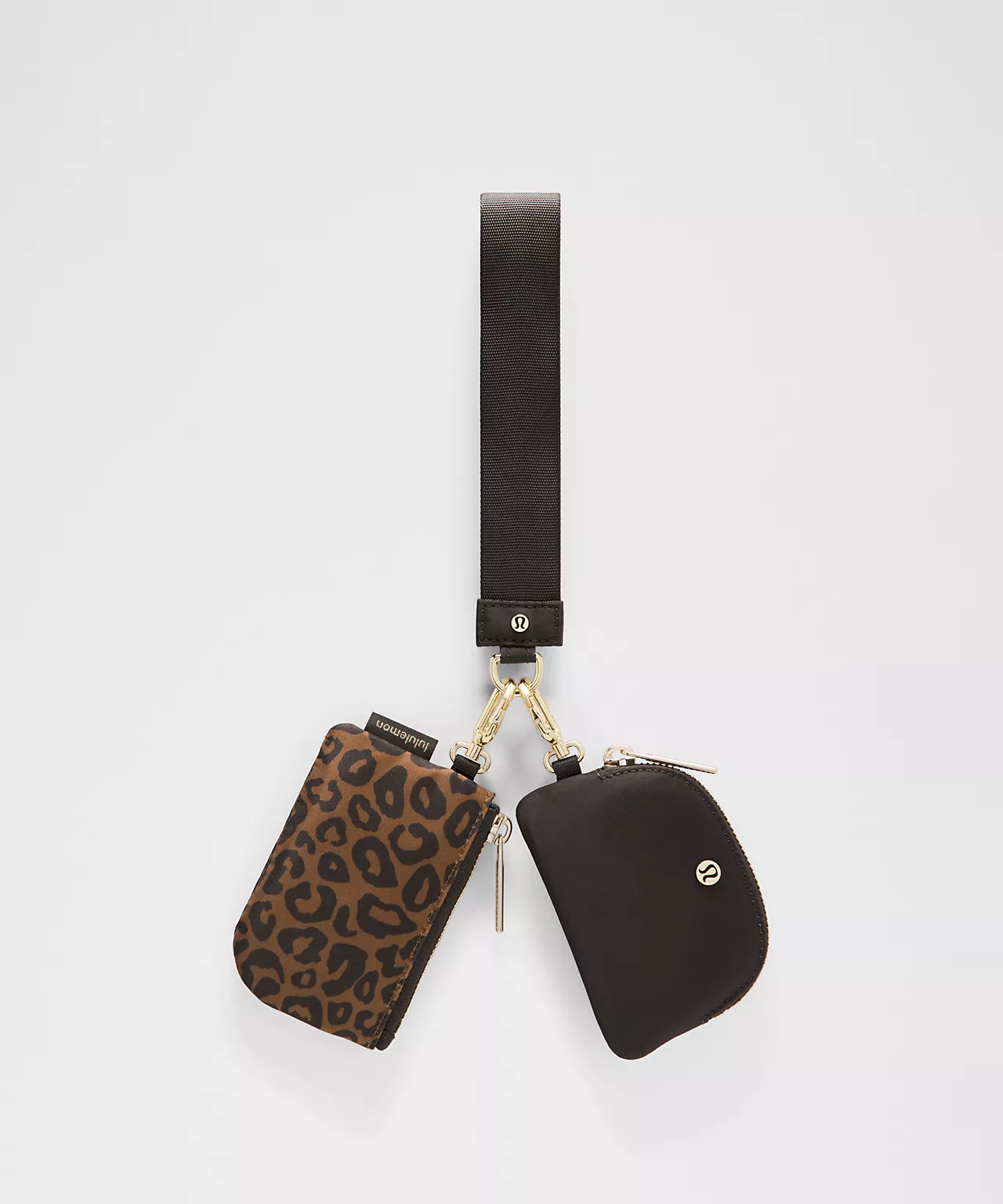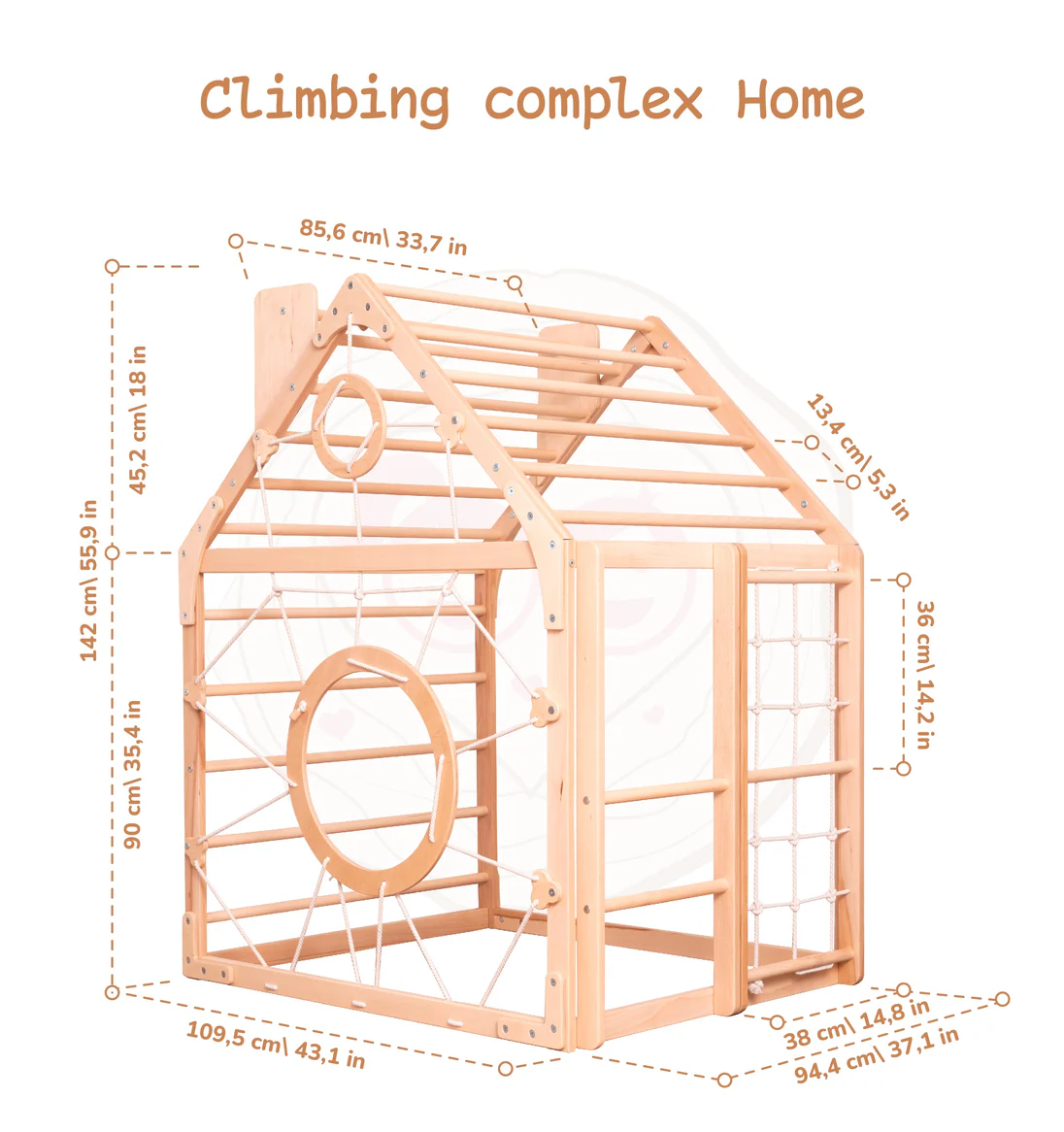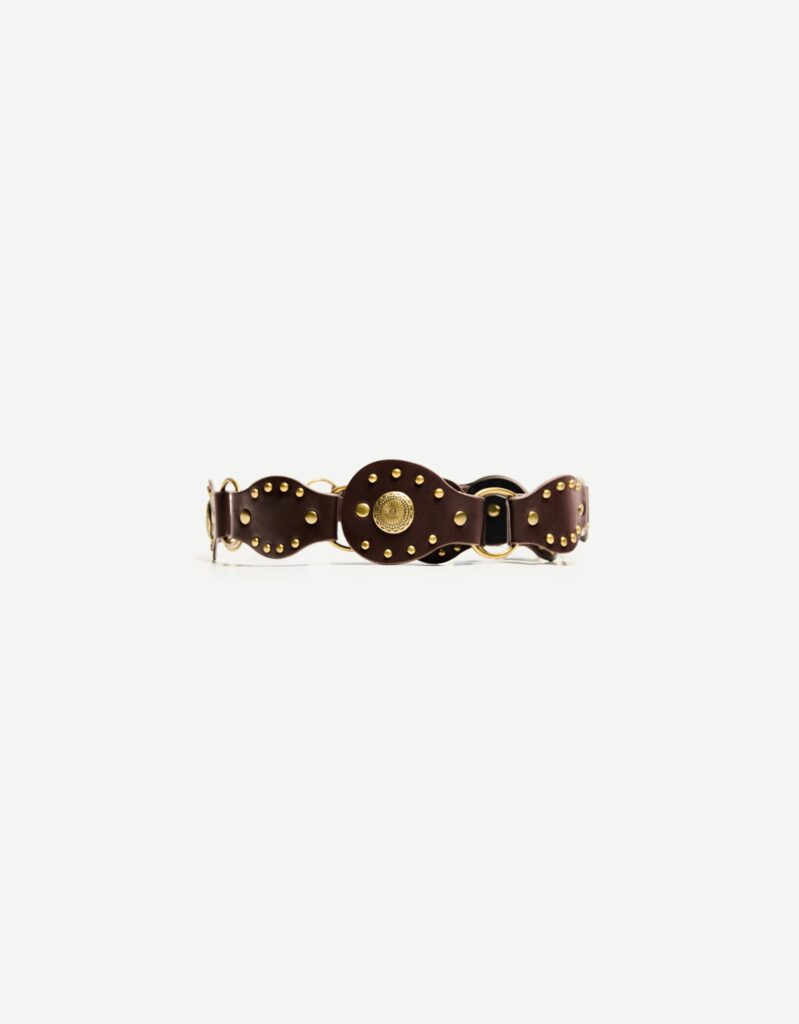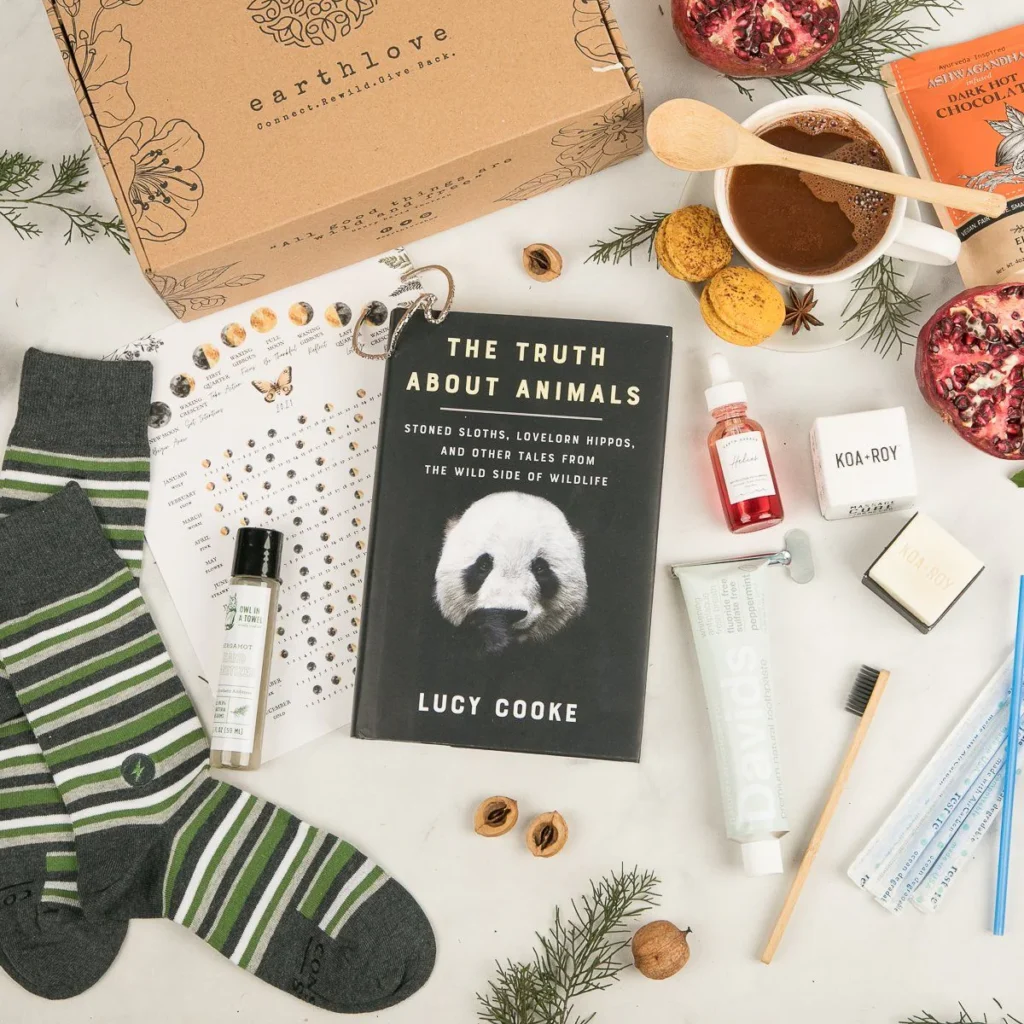Every great kids’ toy pulls double duty: it soothes and sparks curiosity. The right plush becomes a steady friend for naps and new places, and a surprisingly powerful tool for language, self-regulation, and imaginative play.
In this guide, we’ll show you how to make the most of Timmy Turtle—from first cuddles to preschool storytelling—so this small, soft friend supports big milestones. You’ll get age-by-age play ideas, a simple routine for bedtime calm, travel and transitions strategies, easy cleaning steps, and quick safety checks so you can play with confidence.
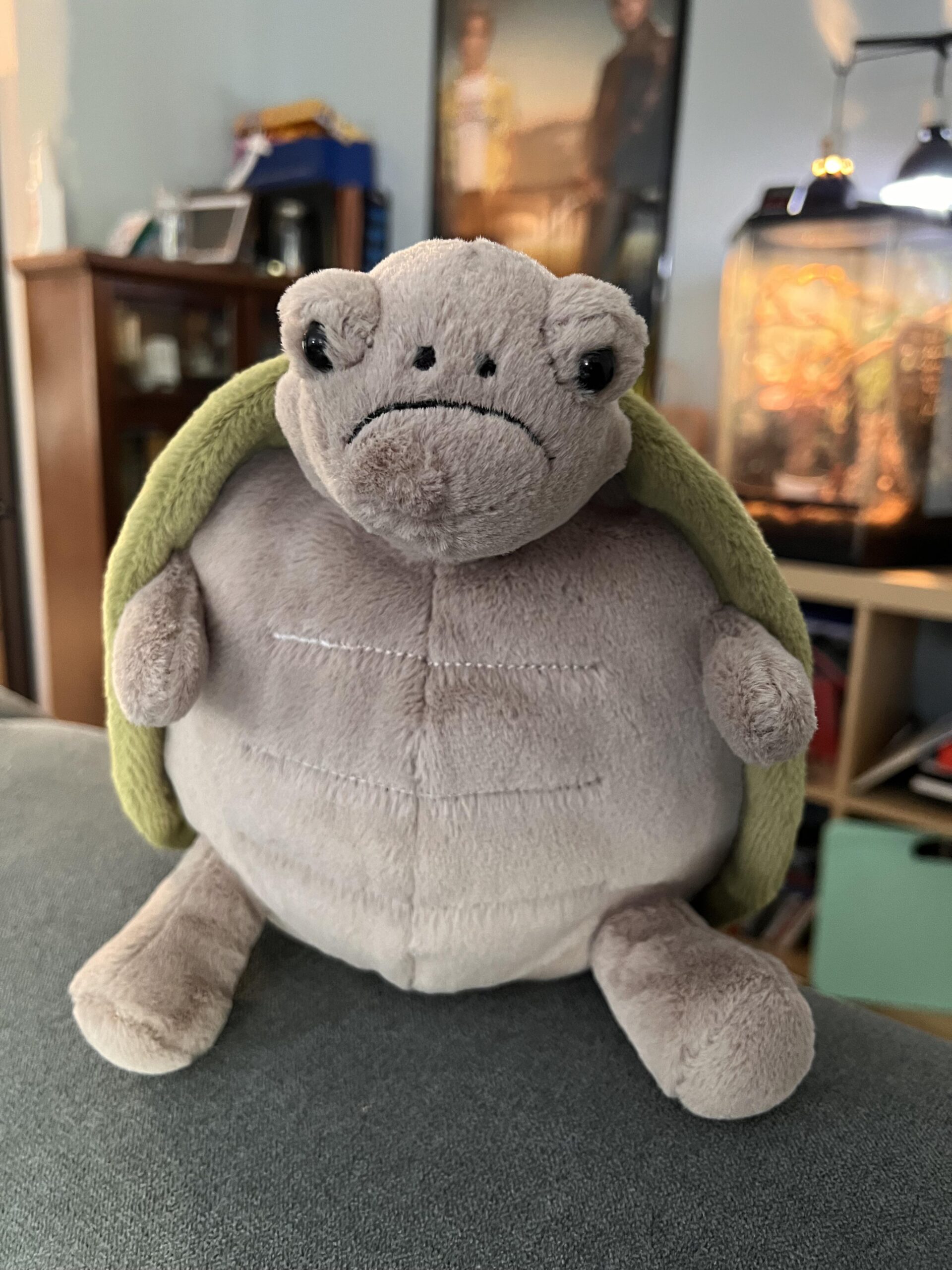
Why a Single Plush Can Do So Much
A plush is more than a cute face. It’s a portable “safe base” that helps kids try new things: the first day at daycare, a long car ride, a checkup. Timmy Turtle adds a friendly, nature-themed character that fits into ocean stories, beach trips, and “under the sea” pretend play. Soft textures help with sensory regulation (petting or squeezing can settle big feelings), while the compact size fits little hands and backpacks. Bonus for caregivers: one character becomes a storytelling anchor you can reinvent across months without new purchases.
Safety First: Quick Checks Before Play
- Age-appropriate: For infants, remove loose accessories from the sleep space and supervise awake play. Plush toys should not be left in a crib with sleeping babies.
- Seams & eyes: Give a gentle tug test on seams and features before handing over to toddlers who explore vigorously.
- Labels & care: Keep the care tag handy or note the wash method on your phone.
- Allergy awareness: If anyone is sensitive to fragrances or detergents, pre-wash new plush or air it out before cuddles.
The Bedtime Routine (5 Minutes, Big Results)
Consistency beats complexity. Try this short “Turtle Tuck-In” sequence:
- Snuggle minute: Two deep breaths together, slow pets on Timmy Turtle (down the shell, count to five).
- Micro-story: “Where did Timmy swim today?” One-sentence recap from your child, you mirror it back.
- Goodnight touches: “Goodnight flippers, goodnight shell,” tapping each.
- Lights low: Place Timmy next to the pillow or on a nearby shelf if your child is very young; older kids can hold him as they settle.
Why it works: the tactile rhythm + predictable script signals wind-down and gives kids an active role in ending the day.
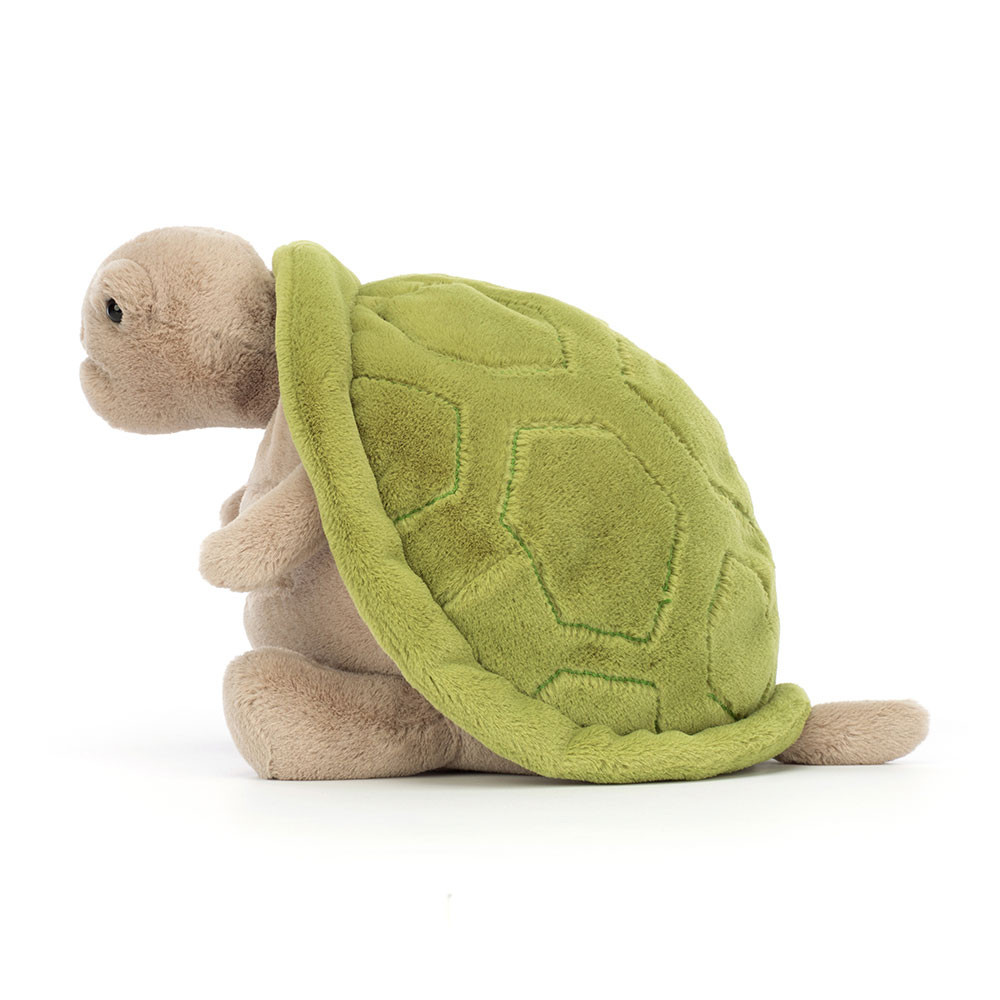
Play Ideas by Age (Use What You Have at Home)
0–12 Months: Sensory & Bonding
- Texture trails: Stroke the shell and flippers across baby’s forearms and legs while you narrate (“soft turtle swim”).
- Peekaboo currents: Hide Timmy Turtle under a muslin, reveal slowly to build anticipation and eye tracking.
- Tummy-time cheerleader: Prop Timmy within reach to motivate presses and swats; narrate each “boop” to model language.
12–24 Months: First Words & Imitation
- Action labels: “Turtle goes, turtle stops, turtle hides.” Pair simple verbs with movement.
- Feed the turtle: Offer safe pretend food (blocks) and practice turn-taking: “Your turn to feed Timmy, now Timmy feeds you (pretend!).”
- Where’s home?: Use a mixing bowl “reef.” Place Timmy in/out to teach spatial words: in, on, under, behind.
2–3 Years: Stories & Feelings
- Feelings mirror: “Timmy looks shy. What helps?” Let your child choose: a hug, a song, or a slow breath.
- Color scavenger: “Find something green like Timmy’s shell!” Great for indoor days.
- Mini missions: “Timmy lost his shell pattern. Can you draw it?” Trace circles/hexagons; place the drawing as “armor.”
3–4 Years: Problem-Solving & Pretend Play
- Tide pool rescue: Build a simple obstacle course (pillows = rocks). Timmy needs help crossing. Narrate plans, try, adjust.
- Map & travel: Tape a paper “ocean map” to the floor. Sail from “Coral City” to “Kelp Forest” to “Grandma’s House Reef.”
- STEM-ish stack: Balance blocks on Timmy’s “island” (a coaster). Which shapes stack best?
4–6 Years: Early Literacy & Cooperation
- Story starter cards: Write prompts (“Timmy meets a crab,” “A storm is coming”). Your child draws one and tells the story; you add a sentence.
- Kindness missions: Timmy leaves tiny notes: “Can we set the table?” “Let’s feed the pet.” Plausible magic keeps chores fun.
- Fact vs. fiction: Look at ocean photos and sort what’s real (turtles breathe air) vs. pretend (sparkly shells). It builds critical thinking gently.
Language Boosters You Can Use Today
- Describe, don’t quiz: “You’re brushing Timmy’s shell in circles,” invites more language than “What color is this?”
- Parallel talk: Narrate what your child is doing: “Timmy is hiding under the blanket; you’re peeking!”
- Expand & echo: Child: “Timmy sleep.” You: “Timmy is sleeping in his cozy reef; we can whisper.”
Social–Emotional Learning (SEL): Big Feelings, Small Turtle
Children often project their feelings onto toys. Use that:
- Name the feeling: “Timmy’s sad because he can’t find his rock. What could help?”
- Choice-making: Offer two strategies (hug or breath) and let your child choose—practicing agency.
- Repair scripts: If there’s sibling friction, let Timmy “apologize” first; model the exchange and invite kids to try.
Sensory Play (Mess-Free and Mess-Optional)
- Gentle squeeze set: Squeeze Timmy together for five counts; release. Repeat three times. Helps reset after overstimulation.
- Ocean bin (mess optional): Dry version = blue scarves, shells, cups; wet version = water with a drop of blue food coloring, plastic sea creatures. Timmy “supervises” from the towel.
- Pattern paths: Use painter’s tape to make a “current” on the floor. Swim Timmy along curves, zigzags, and figure-eights for gross-motor fun.
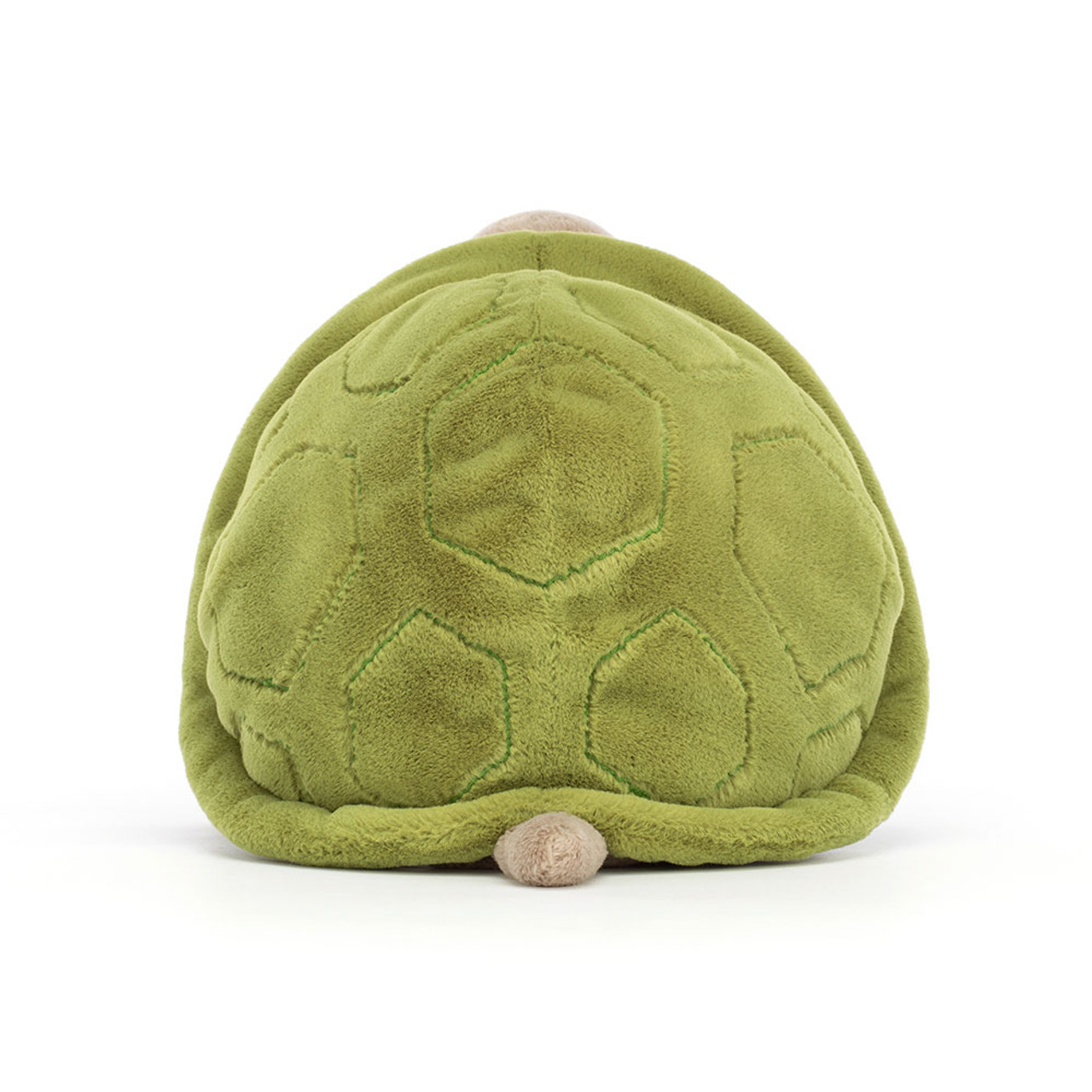
Transitions & Travel: Take Calm on the Road
- Goodbye routine: Before daycare, let your child put a “brave sticker” on Timmy Turtle. You take Timmy to the car; they know the sticker goes with you and you’ll meet again.
- Car rides: Seat Timmy with a small “passport”—a folded index card. Stamp it (draw a star) at stops to make errands feel like adventures.
- New places: Walk Timmy around the room: “Let’s show him the sink, the chair, the window.” Narration + movement reduces novelty anxiety.
Cleaning & Care (Simple, Gentle, Consistent)
Always follow the care tag on your specific toy. General-safe approach for most plush:
- Surface clean first: Use a damp cloth with a drop of mild soap; dab, then blot with clean water.
- Spot treat: For stubborn marks, mix a tiny bit of gentle detergent with water; test on an inconspicuous area.
- Dry right: Air-dry thoroughly. Fluff by hand once dry. Avoid high heat; it can warp stuffing and trim.
- Freshen: Between washes, sunbathe briefly in indirect light or use a fabric steamer at a safe distance to freshen fibers.
Storage & Backup Strategy (Because “Where’s Timmy?” Happens)
- Home base: Pick one visible “reef” (shelf/bin) so Timmy has a consistent home. Kids love returning friends to their spot.
- Backup twin: If your child forms a deep attachment, consider a second Timmy Turtle to rotate during washing or emergencies. Keep them on similar wear cycles so they feel and smell alike.
- Name tag: A tiny tag inside the seam or on a ribbon loop with your phone number can save the day at parks or preschool.
Gift Notes: Make It Personal
Turn Timmy Turtle into a keepsake with a small card: “This turtle goes where you go.” For new siblings, Timmy “brings” a note asking for a helper. For birthdays, tuck a mini book or printed ocean map into the gift bag and start the first story together.
Quick Wins: One Mixed Block (Bullets + Guidance)
- One sentence story at bedtime keeps the routine short but meaningful.
- Two textures nearby (soft blanket + plush) doubles sensory regulation.
- Three calm breaths together with Timmy on the belly makes breathing visible.
- Four verbs to rotate during play: swim, hide, rest, help.
- Five-minute tidy where Timmy “leads” cleanup; kids mirror the turtle’s actions.
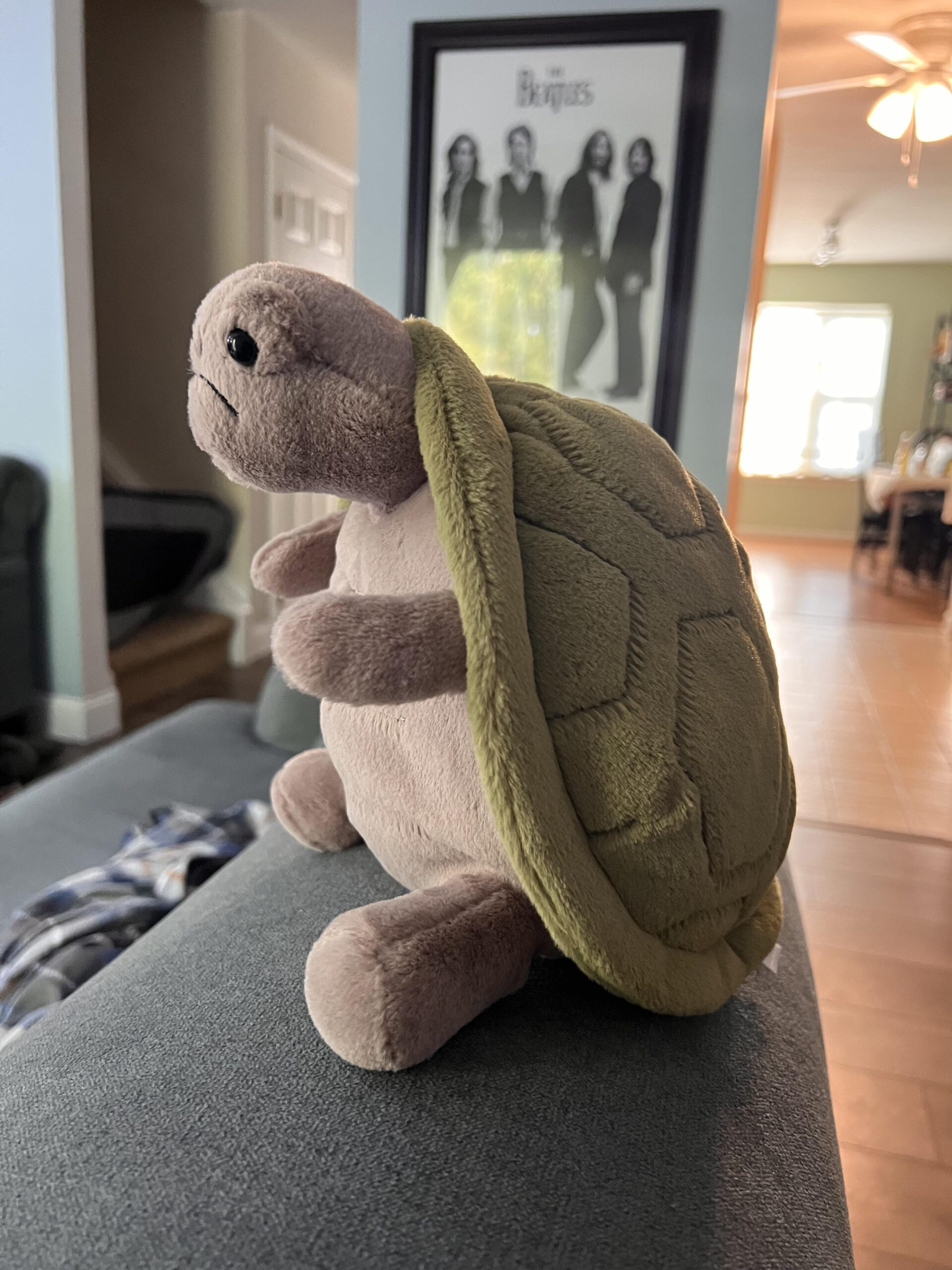
Troubleshooting: Common Snags, Fast Fixes
- “My child throws toys when upset.” Teach Timmy to “take a break” in a calm corner. After the storm, bring him back with a repair script: “Timmy felt mad and needed space; now he’s ready to play gentle.”
- “They won’t let Timmy leave the bed.” Create a daytime mini version (print a turtle picture on cardstock) that “goes to school,” while plush Timmy “guards the pillow” until pickup.
- “They won’t talk about feelings.” Talk to Timmy: “You look disappointed.” Many kids respond more freely in third person.
- “Travel meltdown.” Give Timmy a job: “Count five airport signs with Timmy,” or “Help Timmy find three blue things.” Anchoring attention reduces overwhelm.
Sustainability & Value: Less Stuff, More Stories
The best toys scale with your child. Timmy Turtle can be a sensory tool for infants, a language buddy for toddlers, and a story partner for preschoolers—no batteries, no app, just imagination and routines that grow. That longevity means fewer novelty buys and more memories tied to a single, well-loved friend.
Conclusion
A small plush can shape big moments. With a simple bedtime ritual, a few age-appropriate play ideas, and a calm-first approach to travel and transitions, Timmy Turtle becomes more than a cute shell—he’s a steady presence that helps kids practice words, solve mini-problems, and self-soothe when days feel big. Keep care simple, store him where kids can succeed, and let one friendly character be the thread that ties your stories—and your days—together.
FAQ
- Is Timmy Turtle safe for newborns?
Use during supervised awake time only; keep plush items out of the crib for sleeping infants. Always inspect seams and features before first use. - How do I clean the plush without ruining the softness?
Start with spot cleaning and air-drying. For a deeper refresh, follow the care label; avoid high heat or harsh detergents that can stiffen fibers. - Can this help with separation anxiety?
Yes. Make Timmy part of a predictable goodbye ritual (sticker on Timmy, high-five, short script). Consistency helps transitions. - What learning skills can a plush actually support?
Language (narration, new words), SEL (naming feelings, repair scripts), and early problem-solving (mini missions, obstacle courses) through pretend play. - Is a backup worth it?
If your child is deeply attached, keeping a spare for laundry days and emergencies can prevent a bedtime crisis. Rotate them so they feel alike. - Any quick travel tips?
Give Timmy a “passport,” collect stamps (drawn stars) at stops, and let your child show Timmy new places. It turns errands and airports into adventures. - How do I keep play fresh over months?
Change the setting (bath-time boats, blanket forts), introduce simple prompts (“storm coming,” “lost shell pattern”), and let your child lead the story. - Will older kids still enjoy this?
Absolutely—older preschoolers love making up stories, creating maps, and teaching Timmy “tricks.” Your role shifts from leader to audience and co-author.

